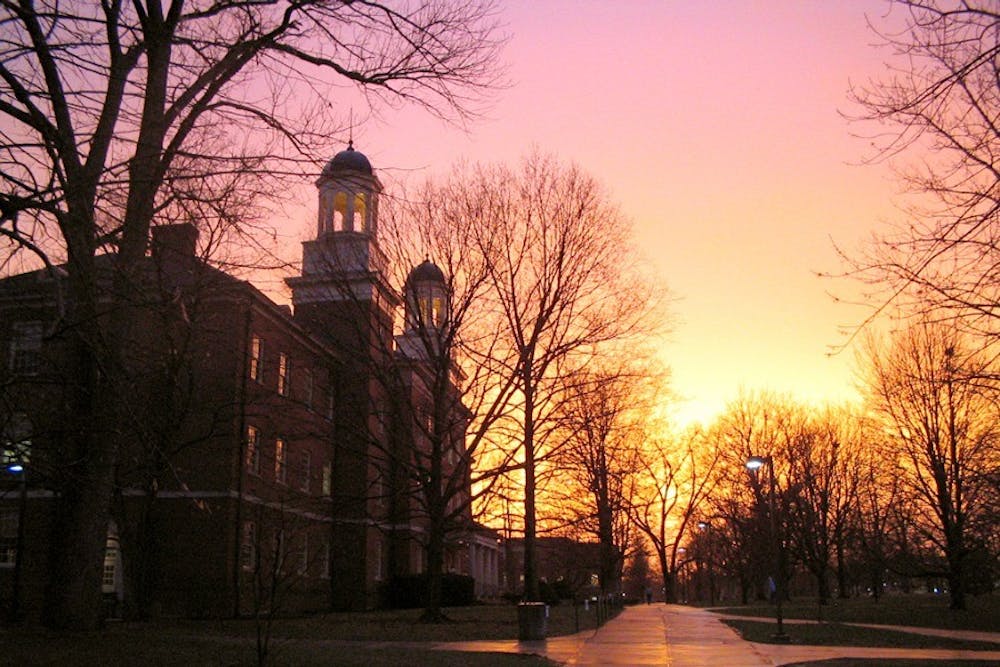By Paris Franz, For The Miami Student
Miami is currently wrapping up its 2015 Sustainability Commitments and Goals (SCAG). The 2015 SCAG builds on the progress and goals made under Miami's 2010 SCAG.
Miami's 2010 SCAG, signed and endorsed in spring 2011 by university president David Hodge, established LEED silver certification as a goal for buildings on campus. The 2015 SCAG will provide project teams with more flexibility, allowing LEED version 4, Green Globes or the Living Building Challenge rating systems to be used to best match the projects' needs.
The Leadership in Energy and Environmental Design (LEED) certification system is one of the most well known third-party green building certification programs used internationally. Under the LEED certification systems, different elements of a building can receive a certain amount of credits based on how they contribute to the building's sustainability. Buildings that achieve 50-59 credits qualify for silver certification.
The first building on the Oxford campus to be LEED silver certified was the Farmer School of Business in 2009. There are currently six LEED silver certified buildings on the Oxford campus, including Farmer, Maple Street Station, Etheridge Hall, Anderson Hall, McFarland Hall and Western Dining Hall.
Miami's Sustainability Committee also anticipates that Armstrong Student Center Phase One, Collins Hall, Dennison Hall, Dorsey Hall, McBride Hall, Symmes Hall, Shideler Hall, Garden Commons, Beechwoods Hall, Stonebridge Hall and Hillcrest Hall will be LEED silver certified once the applications are processed, raising Miami's LEED square footage to over one million square feet.
"We can't say what it's going to be until we get all of our credits approved, but we do also anticipate that [the buildings] will be LEED silver," said Yvette Kline, director of sustainability and energy conservation. "Sometimes what you have to do is, not go back and do different things to the building, but do a better job of explaining what you did in order to get the credits approved; to gather up and submit all of the backup information to justify that you are deserving of those points."
Kline believes that an increase in student interest in campus sustainability has influenced the university's environmental goals.
"Students have been expressing, and had been for quite a while, interest in being on a campus that's environmentally sustainable, and LEED does allow you to do that with a system that is pretty well recognized," said Kline.
Kline also acknowledged a general shift toward sustainability among institutions of higher education.
"We keep track of what our peers are doing and what overall higher education is doing, and there is the responsibility - to the extent that you can afford - to be leading those kinds of things rather than trailing them," Kline said.
Miami's dedication to maintaining the history of its campus, and thus the historical style of its architecture, has created some challenges regarding sustainable construction.
Enjoy what you're reading?
Signup for our newsletter
"When you're keeping with a particular architectural language, as our buildings are, there are certain things you are constrained to do. There are certain credits in LEED
that could favor a light roof, but we are not going to do that because it doesn't fit in with our architectural style," said Kline. "But a whole lot happens beyond the surfaces that really allows these buildings to be highly energy efficient. The insulation values, the details of the windows, and the details of the construction all come into play to allowing us to have these energy-efficient buildings that still meet our architectural style."
Associate professor of geography David Prytherch teaches in newly renovated Shideler Hall, which reopened in January. He hopes that his position in the building will allow him to make students more aware of the sustainability features of Miami's campus.
"You wouldn't know that Shideler was a green building from looking at it. I think that most of the sustainability features are not obvious to the visitor," said Prytherch. "We're hoping in Shideler Hall that we can work with students to better communicate what makes this building green. Miami does a good job of making its buildings green; we hope that we can also help communicate to students so they can learn more about what sustainability means on campus."
Senior Savannah Pocisk, president of the student organization Green Oxford, said although she does not believe many people at Miami know about LEED certification, students are starting to care more about sustainability.
"I think as more people learn about [sustainability], it's certain to become something we care about more," Pocisk said. "The past couple of years, more people have been using reusable water bottles to decrease their waste because they know that their individual choices are making a difference and have a greater and larger impact."
Pocisk also added that she liked the effort Miami has put toward becoming more eco-friendly.
"I'm really happy with the direction that Miami is going, with the SCAG they have created," Pocisk said. "I think it's a really awesome movement, as we've seen with the new bike paths and water bottle refill stations, and that we're really rushing to become a more eco-friendly, sustainable campus."




